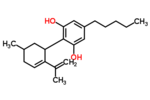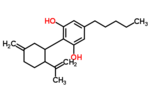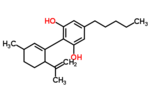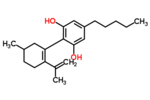「カンナビジオール」の版間の差分
編集の要約なし |
|||
| 2行目: | 2行目: | ||
'''カンナビジオール'''([[国際一般名]]:Cannabidiol)<ref>{{Cite journal|year=2016|title=International Nonproprietary Names for Pharmaceutical Substances (INN)|url=http://www.who.int/medicines/publications/druginformation/innlists/PL115.pdf|journal=WHO Drug Information|volume=30|issue=2|page=241}}</ref>、略称'''CBD'''は、[[アサ|麻]]に(薬用の大麻以外にも)含まれる、少なくとも113ある[[カンナビノイド]]のひとつ<ref name="Borgelt2013">{{Cite journal|date=February 2013|title=The pharmacologic |
'''カンナビジオール'''([[国際一般名]]:Cannabidiol)<ref>{{Cite journal|year=2016|title=International Nonproprietary Names for Pharmaceutical Substances (INN)|url=http://www.who.int/medicines/publications/druginformation/innlists/PL115.pdf|journal=WHO Drug Information|volume=30|issue=2|page=241}}</ref>、略称'''CBD'''は、[[アサ|麻]]に(薬用の大麻以外にも)含まれる、少なくとも113ある[[カンナビノイド]]のひとつ<ref name="Borgelt2013">{{Cite journal|date=February 2013|title=The pharmacologic |
||
and clinical effects of medical cannabis|journal=Pharmacotherapy|volume=33|issue=2|pages=195–209| |
and clinical effects of medical cannabis|journal=Pharmacotherapy|volume=33|issue=2|pages=195–209|doi=10.1002/phar.1187|pmid=23386598}}</ref><ref>{{Cite journal|last=Aizpurua-Olaizola|first=Oier|date=February 2, 2016|title=Evolution of the Cannabinoid and Terpene Content during the Growth ofCannabis sativaPlants from Different Chemotypes|journal=Journal of Natural Products|volume=79|issue=2|pages=324–331|language=EN|doi=10.1021/acs.jnatprod.5b00949|pmid=26836472}}</ref>。主な[[カンナビノイド|フィトカンナビノイド]]で、麻の抽出物の計40%までの割合を占めることもある。アメリカで商品名'''[[エピディオレックス]]'''で医薬品として承認された製品もある。 |
||
多くの試験から良好な安全性の特徴、忍容性があり、[[テトラヒドロカンナビノール]] (∆9-THC、以下THCと表記) のような典型的な効果(精神作用)はなく、乱用、依存、[[身体依存]]、耐性はみられない<ref name="CBD39PP"/>。CBDは広く医療への応用の可能性があるとみなされている―臨床報告によると、副作用が少なく、特に向精神作用がなく、精神運動学習や[[心理学|心理的]]な機能に影響がない事などがその理由である。医薬品としての治験が完了しているものがあり、また規制を緩和した国が見られる。 |
多くの試験から良好な安全性の特徴、忍容性があり、[[テトラヒドロカンナビノール]] (∆9-THC、以下THCと表記) のような典型的な効果(精神作用)はなく、乱用、依存、[[身体依存]]、耐性はみられない<ref name="CBD39PP"/>。CBDは広く医療への応用の可能性があるとみなされている―臨床報告によると、副作用が少なく、特に向精神作用がなく、精神運動学習や[[心理学|心理的]]な機能に影響がない事などがその理由である。医薬品としての治験が完了しているものがあり、また規制を緩和した国が見られる。 |
||
| 28行目: | 28行目: | ||
== 副作用 == |
== 副作用 == |
||
多くの試験から良好な安全性の特徴、忍容性がある<ref name="CBD39PP"/>。ヒトにおけるCBDの安全性に関して行われてきた複数の小規模での研究では、1500 mg/日(経口摂取)か、30 mg(点滴)までの摂取量ならば、十分な忍容性が認められている<ref>{{Cite journal|last=Devinsky O|author=Devinsky O|date=Jun 2014|title=Cannabidiol: pharmacology and potential therapeutic role in epilepsy and other neuropsychiatric disorders|journal=Epilepsia|volume=55|issue=6|pages=791–802| |
多くの試験から良好な安全性の特徴、忍容性がある<ref name="CBD39PP"/>。ヒトにおけるCBDの安全性に関して行われてきた複数の小規模での研究では、1500 mg/日(経口摂取)か、30 mg(点滴)までの摂取量ならば、十分な忍容性が認められている<ref>{{Cite journal|last=Devinsky O|author=Devinsky O|date=Jun 2014|title=Cannabidiol: pharmacology and potential therapeutic role in epilepsy and other neuropsychiatric disorders|journal=Epilepsia|volume=55|issue=6|pages=791–802|doi=10.1111/epi.12631|pmid=24854329|pmc=4707667}}</ref>。毒性は、極めて高い投与量でない限り生理、生化学的に重要な効果を持たないといったことは判明しており、すべての潜在的な作用が判明しているものではないが、比較的低い毒性である<ref name="CBD39PP"/>。 |
||
THCのような典型的な効果やドーパミン遊離作用はなく、動物研究およびヒトで乱用、依存、[[身体依存]]、耐性はみられない<ref name="CBD39PP">{{cite report|author=World Health Organization |coauthors=日本臨床カンナビノイド学会|title=カンナビジオール(CBD)事前審査報告書 |publisher=世界保健機関 |date=2017-12-06|url=http://cannabis.kenkyuukai.jp/images/sys%5Cinformation%5C20171206225443-F93DD6CFE8B1C092970601FFD88BDBE2E5F96AE8B22F18642F02F65C6737547F.pdf |format=pdf|accessdate=2017-12-05}} [http://cannabis.kenkyuukai.jp/information/information_detail.asp?id=73799] {{cite report|author=World Health Organization|title=CANNABIDIOL Pre-Review Report Agenda Item 5.2 : Expert Committee on Drug Dependence Thirty-ninth Meeting |publisher=世界保健機関 |date=2017-12-06|url=http://www.who.int/medicines/access/controlled-substances/5.2_CBD.pdf |format=pdf|accessdate=2017-12-05}}</ref>。 |
THCのような典型的な効果やドーパミン遊離作用はなく、動物研究およびヒトで乱用、依存、[[身体依存]]、耐性はみられない<ref name="CBD39PP">{{cite report|author=World Health Organization |coauthors=日本臨床カンナビノイド学会|title=カンナビジオール(CBD)事前審査報告書 |publisher=世界保健機関 |date=2017-12-06|url=http://cannabis.kenkyuukai.jp/images/sys%5Cinformation%5C20171206225443-F93DD6CFE8B1C092970601FFD88BDBE2E5F96AE8B22F18642F02F65C6737547F.pdf |format=pdf|accessdate=2017-12-05}} [http://cannabis.kenkyuukai.jp/information/information_detail.asp?id=73799] {{cite report|author=World Health Organization|title=CANNABIDIOL Pre-Review Report Agenda Item 5.2 : Expert Committee on Drug Dependence Thirty-ninth Meeting |publisher=世界保健機関 |date=2017-12-06|url=http://www.who.int/medicines/access/controlled-substances/5.2_CBD.pdf |format=pdf|accessdate=2017-12-05}}</ref>。 |
||
| 35行目: | 35行目: | ||
== 薬理 == |
== 薬理 == |
||
カンナビジオールはカンナビノイド受容体のCB<sub>1</sub>とCB<sub>2</sub>に対し、非常に低い[[リガンド|親和性]]を示すが、間接的な[[アンタゴニスト|拮抗剤]]として機能している<ref name="Mechoulam2007">{{Cite journal|date=August 2007|title=Cannabidiol—recent advances|journal=Chem. Biodivers.|volume=4|issue=8|pages=1678–92| |
カンナビジオールはカンナビノイド受容体のCB<sub>1</sub>とCB<sub>2</sub>に対し、非常に低い[[リガンド|親和性]]を示すが、間接的な[[アンタゴニスト|拮抗剤]]として機能している<ref name="Mechoulam2007">{{Cite journal|date=August 2007|title=Cannabidiol—recent advances|journal=Chem. Biodivers.|volume=4|issue=8|pages=1678–92|doi=10.1002/cbdv.200790147|pmid=17712814}}</ref><ref name="cannabinoids">{{Cite journal|last=Pertwee RG|author=Pertwee RG|year=2008|title=The diverse CB1 and CB2 receptor pharmacology of three plant cannabinoids: Δ9-tetrahydrocannabinol, cannabidiol and Δ9-tetrahydrocannabivarin|journal=British Journal of Pharmacology|volume=153|issue=2|pages=199–215|doi=10.1038/sj.bjp.0707442|pmid=17828291|pmc=2219532}}</ref>。このことから、CBDがTHCの効果を減少させるのではないかと考えられるが、逆に、CB1受容体の密度を上げたり、CB1受容体に関連した経路でTHCの効果を上昇させる可能性もある<ref>{{Cite journal|year=2008|title=Cannabidiol potentiates pharmacological effects of Δ9-tetrahydrocannabinol via CB1 receptor-dependent mechanism|journal=Brain Research|volume=1188|pages=157–164|doi=10.1016/j.brainres.2007.09.090|pmid=18021759}}</ref>。 |
||
カンナビジオールは、[[尾状核]]や[[線条体]]に発現するカンナビノイド[[受容体]]とみられる GPR55、[[Gタンパク質共役受容体|G蛋白質共役型受容体]]の拮抗剤である<ref>{{Cite journal|year=2007|title=The orphan receptor GPR55 is a novel cannabinoid receptor|journal=British Journal of Pharmacology|volume=152|issue=7|pages=1092–101| |
カンナビジオールは、[[尾状核]]や[[線条体]]に発現するカンナビノイド[[受容体]]とみられる GPR55、[[Gタンパク質共役受容体|G蛋白質共役型受容体]]の拮抗剤である<ref>{{Cite journal|year=2007|title=The orphan receptor GPR55 is a novel cannabinoid receptor|journal=British Journal of Pharmacology|volume=152|issue=7|pages=1092–101|doi=10.1038/sj.bjp.0707460|pmid=17876302|pmc=2095107}}</ref>。また、CBDは、5-HT<sub>1A</sub> 受容体の部分[[アゴニスト]]で<ref name="pmid16258853">{{cite journal|last1=Russo|first1=Ethan B.|last2=Burnett|first2=Andrea|last3=Hall|first3=Brian|year=2005|title=Agonistic Properties of Cannabidiol at 5-HT1a Receptors|journal=Neurochemical Research|volume=30|issue=8|pages=1037–1043|doi=10.1007/s11064-005-6978-1|pmid=16258853|coauthors=et al.}}</ref>、この性質が[[抗うつ薬|抗うつ]]<ref name="antid">{{Cite journal|date=January 2010|title=Antidepressant-like effects of cannabidiol in mice: possible involvement of 5-HT1A receptors|journal=British Journal of Pharmacology|volume=159|issue=1|pages=122–8|doi=10.1111/j.1476-5381.2009.00521.x|pmid=20002102|pmc=2823358}}</ref><ref name="pmid19133999">{{Cite journal|date=January 2009|title=5-HT1A receptors are involved in the cannabidiol-induced attenuation of behavioural and cardiovascular responses to acute restraint stress in rats|journal=British Journal of Pharmacology|volume=156|issue=1|pages=181–8|doi=10.1111/j.1476-5381.2008.00046.x|pmid=19133999|pmc=2697769}}</ref>、抗不安<ref name="pmid18446323">{{Cite journal|date=August 2008|title=Involvement of 5HT1A receptors in the anxiolytic-like effects of cannabidiol injected into the dorsolateral periaqueductal gray of rats|journal=Psychopharmacology|volume=199|issue=2|pages=223–30|doi=10.1007/s00213-008-1168-x|pmid=18446323}}</ref>、神経細胞保護<ref name="pmid15845890">{{Cite journal|date=May 2005|title=Cannabidiol prevents cerebral infarction via a serotonergic 5-hydroxytryptamine1A receptor-dependent mechanism|journal=Stroke; a Journal of Cerebral Circulation|volume=36|issue=5|pages=1077–82|doi=10.1161/01.STR.0000163083.59201.34|pmid=15845890}}</ref><ref name="pmid17320118">{{Cite journal|date=March 2007|title=Repeated treatment with cannabidiol but not Delta9-tetrahydrocannabinol has a neuroprotective effect without the development of tolerance|journal=Neuropharmacology|volume=52|issue=4|pages=1079–87|doi=10.1016/j.neuropharm.2006.11.005|pmid=17320118}}</ref>などのCBDの作用に関わっている可能性がある。CBDは μ および δオピオイド受容体の間接的な作動薬でもある<ref>{{Cite journal|year=2006|title=Cannabidiol is an allosteric modulator at mu- and delta-opioid receptors|journal=Naunyn-Schmiedeberg's Archives of Pharmacology|volume=372|issue=5|pages=354–361|doi=10.1007/s00210-006-0033-x|pmid=16489449}}</ref>。CBDの薬理効果は[[PPARγ|PPARy]]の[[アゴニスト]]、[[シグナル伝達|細胞内カルシウムの放出]]に起因する<ref name="Campos2012">{{Cite journal|date=December 2012|title=Multiple mechanisms involved in the large-spectrum therapeutic potential of cannabidiol in psychiatric disorders|journal=Philos. Trans. R. Soc. Lond., B, Biol. Sci.|volume=367|issue=1607|pages=3364–78|doi=10.1098/rstb.2011.0389|pmid=23108553|pmc=3481531}}</ref>。 |
||
CBDは、[[脂肪酸アミド加水分解酵素]] (FAAH)を抑制する事で、体内で生成されている[[アナンダミド]]などの内因性カンナビノイドの濃度を上げる事によって、薬理作用を生じさせているようである。CBDの代謝物にも薬理作用があり、CBDの生理作用に貢献していると推測される。<ref>{{Cite journal|year=2014|title=Human metabolites of cannabidiol: a review on their formation, biological activity, and relevance in therapy|journal=Cannabis and Cannabinoid Research|volume=1|issue=1|pages=90–101| |
CBDは、[[脂肪酸アミド加水分解酵素]] (FAAH)を抑制する事で、体内で生成されている[[アナンダミド]]などの内因性カンナビノイドの濃度を上げる事によって、薬理作用を生じさせているようである。CBDの代謝物にも薬理作用があり、CBDの生理作用に貢献していると推測される。<ref>{{Cite journal|year=2014|title=Human metabolites of cannabidiol: a review on their formation, biological activity, and relevance in therapy|journal=Cannabis and Cannabinoid Research|volume=1|issue=1|pages=90–101|doi=10.1089/can.2015.0012}}</ref> |
||
== 薬物動態相互作用 == |
== 薬物動態相互作用 == |
||
カンナビジオールは、THCの[[クリアランス (医学)|クリアランス]]を減少させ、THCの血漿濃度を適度に上昇させ、受容体に利用可能なTHCの量を増加させ、用量依存的にTHCの効果を助長するという前臨床的な証拠がある<ref name="pmid7493549">{{Cite journal|date=August 1995|title=Effect of cannabidiol pretreatment on the kinetics of tetrahydrocannabinol metabolites in mouse brain|journal=Drug Metabolism and Disposition|volume=23|issue=8|pages=825–831| |
カンナビジオールは、THCの[[クリアランス (医学)|クリアランス]]を減少させ、THCの血漿濃度を適度に上昇させ、受容体に利用可能なTHCの量を増加させ、用量依存的にTHCの効果を助長するという前臨床的な証拠がある<ref name="pmid7493549">{{Cite journal|date=August 1995|title=Effect of cannabidiol pretreatment on the kinetics of tetrahydrocannabinol metabolites in mouse brain|journal=Drug Metabolism and Disposition|volume=23|issue=8|pages=825–831|pmid=7493549}}</ref><ref name="pmid21667074">{{Cite journal|date=November 2011|title=Cannabidiol potentiates Δ⁹-tetrahydrocannabinol (THC) behavioural effects and alters THC pharmacokinetics during acute and chronic treatment in adolescent rats|journal=Psychopharmacology|volume=218|issue=2|pages=443–457|doi=10.1007/s00213-011-2342-0|pmid=21667074}}</ref>。それにもかかわらず、ヒトに関する証拠では、THC血漿レベルに対するCBDの有意な効果を示唆していない<ref>{{Cite journal|date=June 1981|title=Evidence that Cannabidiol Does Not Significantly Alter the Pharmacokinetics of Tetrahydrocannabinol in Man|journal=Journal of Pharmacokinetics and Biopharmaceutics|volume=9|issue=3|pages=245–260|doi=10.1007/BF01059266|pmid=6270295}}</ref>。 |
||
カンナビシオールは、[[シトクロムP450]]の[[CYP3A]]と[[シトクロムP450#分類・命名|CYP2C]]酵素を阻害する事によって、THCの効果持続時間を伸ばす可能性もある<ref>Alchimia Blog, ''[http://www.alchimiaweb.com/blogen/cannabinoids-and-their-medicinal-properties/ Cannabinoids and their medicinal properties]''</ref>{{信頼性要検証|date=March 2017}}。カンナビジオールの製品であるエピディオレックスの治験では、他の抗てんかん薬との相互作用は、[[クロバザム]]を除き血中濃度の変化は許容範囲内であった<ref name="pmid28782097">{{cite journal|last1=Gaston|first1=Tyler E.|last2=Bebin|first2=E. Martina|last3=Cutter|first3=Gary R.|coauthors=et al.|title=Interactions between cannabidiol and commonly used antiepileptic drugs|journal=Epilepsia|volume=58|issue=9|pages=1586–1592|year=2017|pmid=28782097|doi=10.1111/epi.13852}}</ref>。 |
カンナビシオールは、[[シトクロムP450]]の[[CYP3A]]と[[シトクロムP450#分類・命名|CYP2C]]酵素を阻害する事によって、THCの効果持続時間を伸ばす可能性もある<ref>Alchimia Blog, ''[http://www.alchimiaweb.com/blogen/cannabinoids-and-their-medicinal-properties/ Cannabinoids and their medicinal properties]''</ref>{{信頼性要検証|date=March 2017}}。カンナビジオールの製品であるエピディオレックスの治験では、他の抗てんかん薬との相互作用は、[[クロバザム]]を除き血中濃度の変化は許容範囲内であった<ref name="pmid28782097">{{cite journal|last1=Gaston|first1=Tyler E.|last2=Bebin|first2=E. Martina|last3=Cutter|first3=Gary R.|coauthors=et al.|title=Interactions between cannabidiol and commonly used antiepileptic drugs|journal=Epilepsia|volume=58|issue=9|pages=1586–1592|year=2017|pmid=28782097|doi=10.1111/epi.13852}}</ref>。 |
||
| 49行目: | 49行目: | ||
== 化学 == |
== 化学 == |
||
カンナビジオールは水溶性ではないが、[[ペンタン]]などの有機溶媒には溶ける。室温では、透明な結晶の個体である。<ref>{{Cite journal|year=1977|title=Cannabidiol|journal=Acta Crystallogr. B|volume=33|issue=10|pages=3211–3214| |
カンナビジオールは水溶性ではないが、[[ペンタン]]などの有機溶媒には溶ける。室温では、透明な結晶の個体である。<ref>{{Cite journal|year=1977|title=Cannabidiol|journal=Acta Crystallogr. B|volume=33|issue=10|pages=3211–3214|doi=10.1107/S0567740877010577}}</ref> 強塩基性媒体および空気中では、キノンに酸化される<ref>{{Cite journal|year=1968|title=Hashish—XIII On the nature of the beam test|journal=Tetrahedron|volume=24|issue=16|pages=5615–5624|doi=10.1016/0040-4020(68)88159-1|pmid=5732891}}</ref>。カンナビジオールの合成は、いくつかの研究グループによって達成されている<ref>{{Cite journal|year=1967|title=Synthese und Chiralität des (−)-Cannabidiols|journal=Helv. Chim. Acta|volume=50|issue=2|pages=719–723|doi=10.1002/hlca.19670500235|pmid=5587099}}</ref><ref>{{Cite journal|year=1985|title=Boron trifluoride etherate on alumuna — a modified Lewis acid reagent. An improved synthesis of cannabidiol|journal=Tetrahedron Letters|volume=26|issue=8|pages=1083–1086|doi=10.1016/S0040-4039(00)98518-6}}</ref><ref>{{Cite journal|year=2006|title=Synthesis of cannabidiols via alkenylation of cyclohexenyl monoacetate|journal=Org. Lett.|volume=8|issue=13|pages=2699–2702|doi=10.1021/ol060692h|pmid=16774235}}</ref>。 |
||
=== 生合成 === |
=== 生合成 === |
||
[[アサ|麻]]は、CBDAシンターゼがTHCAシンターゼの代わりに触媒作用を行う最終段階まで、THCと同じ代謝経路を介してCBD-[[カルボン酸]]を生成する<ref>{{Cite journal|year=2009|title=Identification of candidate genes affecting Δ9-tetrahydrocannabinol biosynthesis in Cannabis sativa|journal=Journal of Experimental Botany|volume=60|issue=13|pages=3715–3726| |
[[アサ|麻]]は、CBDAシンターゼがTHCAシンターゼの代わりに触媒作用を行う最終段階まで、THCと同じ代謝経路を介してCBD-[[カルボン酸]]を生成する<ref>{{Cite journal|year=2009|title=Identification of candidate genes affecting Δ9-tetrahydrocannabinol biosynthesis in Cannabis sativa|journal=Journal of Experimental Botany|volume=60|issue=13|pages=3715–3726|doi=10.1093/jxb/erp210|pmid=19581347|pmc=2736886}}</ref>。 |
||
[[ファイル:Cannabidiol and THC Biosynthesis.jpg|中央|サムネイル|581x581ピクセル|カンナビジオールとTHCの生合成<ref>{{Cite journal|last=Taura, F., Sirikantaramas, S., Shoyama, Y., Yoshikai, K., Shoyama, Y., Morimoto, S.|author=Taura, F., Sirikantaramas, S., Shoyama, Y., Yoshikai, K., Shoyama, Y., Morimoto, S.|year=2007|title=Cannabidiolic-acid synthase, the chemotype-determining enzyme in the fiber-type ''Cannabis'' sativa|journal=FEBS Letters|volume=581|issue=16|pages=2929–34| |
[[ファイル:Cannabidiol and THC Biosynthesis.jpg|中央|サムネイル|581x581ピクセル|カンナビジオールとTHCの生合成<ref>{{Cite journal|last=Taura, F., Sirikantaramas, S., Shoyama, Y., Yoshikai, K., Shoyama, Y., Morimoto, S.|author=Taura, F., Sirikantaramas, S., Shoyama, Y., Yoshikai, K., Shoyama, Y., Morimoto, S.|year=2007|title=Cannabidiolic-acid synthase, the chemotype-determining enzyme in the fiber-type ''Cannabis'' sativa|journal=FEBS Letters|volume=581|issue=16|pages=2929–34|doi=10.1016/j.febslet.2007.05.043|pmid=17544411}}</ref>]] |
||
=== 異性 === |
=== 異性 === |
||
| 149行目: | 149行目: | ||
=== 法的位置付け === |
=== 法的位置付け === |
||
カンナビジオールは、[[向精神薬に関する条約]]によって規制されておらず、2018年の審査にても国際規制下に置かないことを決定した<ref name="ECDD40letter">{{cite report|author=テドロス・アダノム・ゲブレシウス、(訳)日本臨床カンナビノイド学会|title=国連事務総長(アントニオ・グテーレス氏)への手紙 |publisher=世界保健機関 |date=2018-7-23|url=http://cannabis.kenkyuukai.jp/images/sys%5Cinformation%5C20180903144647-7124AA3F1E5FD3F9580E9146B8B7F50E05DD6699E228F41B3BD8D369697F3411.pdf |format=pdf|accessdate=2019-1-15}} 原文:ECDD 40th meetingの[https://www.who.int/medicines/access/controlled-substances/UNSG_SignedDGletter.pdf Director-General letter] 。翻訳文書の経緯:{{cite web |title=2018年6月 第40回WHO ECDD会議の結果について |url=http://cannabis.kenkyuukai.jp/information/information_detail.asp?id=83062 |date=2018-9-3 |publisher=日本臨床カンナビノイド学会 |accessdate=2019-1-15}}</ref>。CBDは、マリファナのTHCに関連する「高揚感」を引き起こさない。 医学的カンナビノイドとの違いに関する理解と法整備が進展するにつれ、「医療マリファナ」(様々な精神的効果と判断機能の障害が指摘される)を「医療CBD」と区別することがますます重要になるだろう。<ref>{{Cite journal|last=Sachs J ''et al''|author=Sachs J ''et al''|date=Oct 2015|title=Safety and Toxicology of Cannabinoids|journal=Neurotherapeutics|volume=12|issue=4|pages=735–746| |
カンナビジオールは、[[向精神薬に関する条約]]によって規制されておらず、2018年の審査にても国際規制下に置かないことを決定した<ref name="ECDD40letter">{{cite report|author=テドロス・アダノム・ゲブレシウス、(訳)日本臨床カンナビノイド学会|title=国連事務総長(アントニオ・グテーレス氏)への手紙 |publisher=世界保健機関 |date=2018-7-23|url=http://cannabis.kenkyuukai.jp/images/sys%5Cinformation%5C20180903144647-7124AA3F1E5FD3F9580E9146B8B7F50E05DD6699E228F41B3BD8D369697F3411.pdf |format=pdf|accessdate=2019-1-15}} 原文:ECDD 40th meetingの[https://www.who.int/medicines/access/controlled-substances/UNSG_SignedDGletter.pdf Director-General letter] 。翻訳文書の経緯:{{cite web |title=2018年6月 第40回WHO ECDD会議の結果について |url=http://cannabis.kenkyuukai.jp/information/information_detail.asp?id=83062 |date=2018-9-3 |publisher=日本臨床カンナビノイド学会 |accessdate=2019-1-15}}</ref>。CBDは、マリファナのTHCに関連する「高揚感」を引き起こさない。 医学的カンナビノイドとの違いに関する理解と法整備が進展するにつれ、「医療マリファナ」(様々な精神的効果と判断機能の障害が指摘される)を「医療CBD」と区別することがますます重要になるだろう。<ref>{{Cite journal|last=Sachs J ''et al''|author=Sachs J ''et al''|date=Oct 2015|title=Safety and Toxicology of Cannabinoids|journal=Neurotherapeutics|volume=12|issue=4|pages=735–746|doi=10.1007/s13311-015-0380-8|pmid=26269228|pmc=4604177}}</ref><ref>{{Cite journal|year=2015|title=A systematic review of the antipsychotic properties of cannabidiol in humans|journal=Schizophr. Res.|volume=162|issue=1–3|pages=153–61|doi=10.1016/j.schres.2015.01.033|pmid=25667194}}</ref><ref>{{Cite journal|last=Sachs J ''et al''|author=Sachs J ''et al''|date=Oct 2015|title=Safety and Toxicology of Cannabinoids|journal=Neurotherapeutics|volume=12|issue=4|pages=735–746|doi=10.1007/s13311-015-0380-8|pmid=26269228|pmc=4604177}}</ref> |
||
様々な品種/系統の「[[医療大麻]]」は、CBDとTHCの比に大きな多様性があり、他の向精神性のないカンナビノイドを含むことが知られている<ref>{{Cite journal|year=2009|title=Non-psychotropic plant cannabinoids: new therapeutic opportunities from an ancient herb|journal=Trends Pharmacol. Sci.|volume=30|issue=10|pages=515–27| |
様々な品種/系統の「[[医療大麻]]」は、CBDとTHCの比に大きな多様性があり、他の向精神性のないカンナビノイドを含むことが知られている<ref>{{Cite journal|year=2009|title=Non-psychotropic plant cannabinoids: new therapeutic opportunities from an ancient herb|journal=Trends Pharmacol. Sci.|volume=30|issue=10|pages=515–27|doi=10.1016/j.tips.2009.07.006|pmid=19729208}}</ref><ref>{{Cite journal|year=2009|title=Non-psychotropic plant cannabinoids: new therapeutic opportunities from an ancient herb|url=http://www.advancedholistichealth.org/PDF_Files/cannbiniods%20therapeutic%20chart%20article.pdf|journal=Trends Pharmacol. Sci.|volume=30|issue=10|pages=515–27|doi=10.1016/j.tips.2009.07.006|pmid=19729208}}</ref>。CBDを抽出する目的で使用される植物材料が麻と考えられているのか、マリファナと考えられているのかを化学的に判断する材料は、植物の形態ではなくTHCの量である<ref name="pmid28107530">{{cite journal|last1=Scali|first1=Monica|last2=Dufresnes|first2=Christophe|last3=Jan|first3=Catherine|coauthors=et al.|title=Broad-Scale Genetic Diversity of Cannabis for Forensic Applications|journal=PLOS ONE|volume=12|issue=1|pages=e0170522|year=2017|pmid=28107530|pmc=5249207|doi=10.1371/journal.pone.0170522|url=http://journals.plos.org/plosone/article?id=10.1371/journal.pone.0170522}}</ref>。 |
||
あらゆる精神活性マリファナは、そのCBD含量にかかわらず、麻の花(または花穂)に由来する。 |
あらゆる精神活性マリファナは、そのCBD含量にかかわらず、麻の花(または花穂)に由来する。 |
||
| 188行目: | 188行目: | ||
ヨーロッパ産業用大麻協会は、EUにおける規制枠組みを示唆するポジションペーパーを発行した<ref>{{Cite web|url=http://eiha.org/cbd-support/|title=Support the EIHA CBD position paper - EIHA European Industrial Hemp Association |accessdate=2018-09-23}}</ref>。 |
ヨーロッパ産業用大麻協会は、EUにおける規制枠組みを示唆するポジションペーパーを発行した<ref>{{Cite web|url=http://eiha.org/cbd-support/|title=Support the EIHA CBD position paper - EIHA European Industrial Hemp Association |accessdate=2018-09-23}}</ref>。 |
||
いくつかの品種の産業用大麻は、西ヨーロッパで合法的に栽培することができる。Fedora 17 などの品種は、1%以下のカンナビジオール(CBD)と約0.1%未満のTHCを含むカンナビノイドプロファイルを有する。<ref>{{Cite journal|last=Fournier|first=G.|year=2003|title=Intérêt du rapport Δ-9-THC / CBD dans le contrôle des cultures de chanvre industriel|journal=Annales de Toxicologie Analytique|volume=15|issue=4|pages=250–259| |
いくつかの品種の産業用大麻は、西ヨーロッパで合法的に栽培することができる。Fedora 17 などの品種は、1%以下のカンナビジオール(CBD)と約0.1%未満のTHCを含むカンナビノイドプロファイルを有する。<ref>{{Cite journal|last=Fournier|first=G.|year=2003|title=Intérêt du rapport Δ-9-THC / CBD dans le contrôle des cultures de chanvre industriel|journal=Annales de Toxicologie Analytique|volume=15|issue=4|pages=250–259|doi=10.1051/ata/2003003}}</ref> |
||
== 脚注 == |
== 脚注 == |
||
2020年1月25日 (土) 16:30時点における版
 | |
 | |
| IUPAC命名法による物質名 | |
|---|---|
| |
| 臨床データ | |
| 販売名 | Epidiolex |
| Drugs.com |
国別販売名(英語) International Drug Names |
| 法的規制 |
|
| 薬物動態データ | |
| 生物学的利用能 | 13–19% (oral),[2] 11–45% (mean 31%; inhaled)[3] |
| 半減期 | 9 h[2] |
| 識別 | |
| CAS番号 |
13956-29-1 |
| ATCコード | None |
| PubChem | CID: 644019 |
| IUPHAR/BPS | 4150 |
| ChemSpider |
24593618 |
| UNII |
19GBJ60SN5 |
| KEGG | D10915 |
| ChEBI |
CHEBI:69478 |
| 化学的データ | |
| 化学式 | C21H30O2 |
| 分子量 | 314.4636 |
| |
| 物理的データ | |
| 融点 | 66 °C (151 °F) |
| 沸点 | 180 °C (356 °F) (range: 160–180 °C)[4] |
カンナビジオール(国際一般名:Cannabidiol)[5]、略称CBDは、麻に(薬用の大麻以外にも)含まれる、少なくとも113あるカンナビノイドのひとつ[6][7]。主なフィトカンナビノイドで、麻の抽出物の計40%までの割合を占めることもある。アメリカで商品名エピディオレックスで医薬品として承認された製品もある。
多くの試験から良好な安全性の特徴、忍容性があり、テトラヒドロカンナビノール (∆9-THC、以下THCと表記) のような典型的な効果(精神作用)はなく、乱用、依存、身体依存、耐性はみられない[8]。CBDは広く医療への応用の可能性があるとみなされている―臨床報告によると、副作用が少なく、特に向精神作用がなく、精神運動学習や心理的な機能に影響がない事などがその理由である。医薬品としての治験が完了しているものがあり、また規制を緩和した国が見られる。
薬物規制に関する国際条約による規制はない[9]。日本では主にこれを含有する健康食品として流通している[10]。日本で流通しているものは規制対象ではない麻の茎と種から抽出されている[10]。
アメリカ政府が所有する特許「抗酸化物質、神経保護物質としてのカンナビノイド」特許番号:6630507にリストされている物質である[11]。
医薬品製剤
ナビキシモルス(USAN、商品名サティベックス)は、CBDとTHCとの比率が1:1に近い経口投与用スプレーである。 この薬は、多発性硬化症に伴う疼痛を緩和するために、2005年にカナダ当局に承認された[12][13]。
エピディオレックスは、難治性てんかんの臨床試験を実施した、大麻から抽出されたCBDの油脂配合物である[14]。エピディオレックスは、2015年7月にアメリカにおいてドラべ症候群などの治療薬としての希少疾病用医薬品の指定を受け[15]、治験は完了し、2018年に承認された。
エピディオレックスは、欧州医薬品庁 (EMA) からも、2017年にレノックス・ガストー症候群など治療抵抗性のてんかんの希少病用医薬品の指定[16]、2018年に結節性硬化症の同指定とまた治験が進行している[17]。
オランダではエコー製薬による、Arvisolという経口錠剤の治験第I相(初期段階を意味する)が進行しており、対象はてんかんと統合失調症である[8]。
また、FDAとEMAは、新生児の窒息に伴う脳障害の治療に用いる希少疾病用医薬品としてカンナビジオールを指定したが、これに対する既存の医薬品はなかった[8]。
その他の効用

いくつかの神経疾患に対して、カンナビジオールの有効性を示唆する小規模な研究はあるものの、質の高い臨床研究で効果が示されたものはない。
副作用
多くの試験から良好な安全性の特徴、忍容性がある[8]。ヒトにおけるCBDの安全性に関して行われてきた複数の小規模での研究では、1500 mg/日(経口摂取)か、30 mg(点滴)までの摂取量ならば、十分な忍容性が認められている[18]。毒性は、極めて高い投与量でない限り生理、生化学的に重要な効果を持たないといったことは判明しており、すべての潜在的な作用が判明しているものではないが、比較的低い毒性である[8]。
THCのような典型的な効果やドーパミン遊離作用はなく、動物研究およびヒトで乱用、依存、身体依存、耐性はみられない[8]。
カンナビジオールはときに倦怠感、下痢、食欲の変化を生ずる。エピディオレックスの添付文書では、眠気、不眠、睡眠の質の低下、食欲低下、下痢、倦怠感などが注意喚起されている。
薬理
カンナビジオールはカンナビノイド受容体のCB1とCB2に対し、非常に低い親和性を示すが、間接的な拮抗剤として機能している[19][20]。このことから、CBDがTHCの効果を減少させるのではないかと考えられるが、逆に、CB1受容体の密度を上げたり、CB1受容体に関連した経路でTHCの効果を上昇させる可能性もある[21]。
カンナビジオールは、尾状核や線条体に発現するカンナビノイド受容体とみられる GPR55、G蛋白質共役型受容体の拮抗剤である[22]。また、CBDは、5-HT1A 受容体の部分アゴニストで[23]、この性質が抗うつ[24][25]、抗不安[26]、神経細胞保護[27][28]などのCBDの作用に関わっている可能性がある。CBDは μ および δオピオイド受容体の間接的な作動薬でもある[29]。CBDの薬理効果はPPARyのアゴニスト、細胞内カルシウムの放出に起因する[30]。
CBDは、脂肪酸アミド加水分解酵素 (FAAH)を抑制する事で、体内で生成されているアナンダミドなどの内因性カンナビノイドの濃度を上げる事によって、薬理作用を生じさせているようである。CBDの代謝物にも薬理作用があり、CBDの生理作用に貢献していると推測される。[31]
薬物動態相互作用
カンナビジオールは、THCのクリアランスを減少させ、THCの血漿濃度を適度に上昇させ、受容体に利用可能なTHCの量を増加させ、用量依存的にTHCの効果を助長するという前臨床的な証拠がある[32][33]。それにもかかわらず、ヒトに関する証拠では、THC血漿レベルに対するCBDの有意な効果を示唆していない[34]。
カンナビシオールは、シトクロムP450のCYP3AとCYP2C酵素を阻害する事によって、THCの効果持続時間を伸ばす可能性もある[35][信頼性要検証]。カンナビジオールの製品であるエピディオレックスの治験では、他の抗てんかん薬との相互作用は、クロバザムを除き血中濃度の変化は許容範囲内であった[36]。
カンナビジオールを代謝できる酵素は、CYP1A1、CYP1A2、CYP2C9、CYP2C19、CYP2D6、CYP3A4、CYP3A5である[8]。
化学
カンナビジオールは水溶性ではないが、ペンタンなどの有機溶媒には溶ける。室温では、透明な結晶の個体である。[37] 強塩基性媒体および空気中では、キノンに酸化される[38]。カンナビジオールの合成は、いくつかの研究グループによって達成されている[39][40][41]。
生合成
麻は、CBDAシンターゼがTHCAシンターゼの代わりに触媒作用を行う最終段階まで、THCと同じ代謝経路を介してCBD-カルボン酸を生成する[42]。

異性
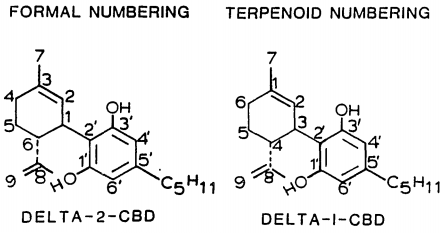
社会と文化
以前はTHCの量が多ければいいと考えられていたが、2008年にアメリカで成分検査のためのラボが誕生し、2009年にはCBDがTHCに比べて比較的多い品種が見つかり、中には痛みに効いたが陶酔しなかったという声もあり、2010年には大麻薬局に持ち込まれるようになり、そしてCBDオイルが登場することとなり、それはリック・シンプソン・オイルの名でまだTHCの多い初の製品が出回った[44]。
2018年よりカンナビジオールは世界ドーピング防止規程の禁止薬物から除外されるが、一部のアスリートは鎮痛を目的としてカンナビジオールを利用している[45]。THCは禁止であるため、THCも多く含有する製品の検査前の使用は薬物検査に失敗するおそれがある[45]。
自然からの調達
これまで米国の栽培者による品種の選択的な栽培は、大麻のCBD含量を劇的に低下させてきた。顧客が、より高いTHC、より低いCBD含有量によって得られる、より精神作用の強い品種を好んだためである[46]。現在、患者らの需要により、栽培者達は、CBDが多く含まれる品種を栽培している[47]。
法的位置付け
カンナビジオールは、向精神薬に関する条約によって規制されておらず、2018年の審査にても国際規制下に置かないことを決定した[9]。CBDは、マリファナのTHCに関連する「高揚感」を引き起こさない。 医学的カンナビノイドとの違いに関する理解と法整備が進展するにつれ、「医療マリファナ」(様々な精神的効果と判断機能の障害が指摘される)を「医療CBD」と区別することがますます重要になるだろう。[48][49][50]
様々な品種/系統の「医療大麻」は、CBDとTHCの比に大きな多様性があり、他の向精神性のないカンナビノイドを含むことが知られている[51][52]。CBDを抽出する目的で使用される植物材料が麻と考えられているのか、マリファナと考えられているのかを化学的に判断する材料は、植物の形態ではなくTHCの量である[53]。
あらゆる精神活性マリファナは、そのCBD含量にかかわらず、麻の花(または花穂)に由来する。 米国での基準として、精神作用のない麻(一般に産業用大麻とも呼ばれる)は、そのCBD含量にかかわらず、成長しているか否かにかかわらず、乾燥重量比で0.3%以下のΔ-9テトラヒドロカンナビノール濃度しか含有しない麻である。麻の合法的な栽培と生産には一定の基準が必要で、コロラド州産業麻プログラム (Colorado Industrial Hemp Program) は、工業用麻およびサンプル作物の生産者を登録して、THC濃度が乾燥重量基準で0.3%を超えないことを確認している[54]。
日本
日本では種子や茎から抽出されたCBDは規制対象ではない[10]。CBDは日本法における規制対象物質には含まれておらず、大麻取締法の第1条は、葉と花穂、その製品を規制しており、種子と茎、その製品を除外しているためである[10]。健康食品として扱われているが、含有量の少ない部位から抽出しているため製品は高額となり、健康保険も適用されない[10]。
アメリカ
2013年にシャーロッツウェブを特集したCNNの番組は、米国内のCBDの含有量が多い麻の需要を増加させた。ケンタッキー州では2013年に法律が制定され、農作物の市場を失っているタバコ農家を支援する経済開発プログラムとして、その州で麻農業を促進した。 2014年農業法の条項に同意し、ケンタッキー州などの麻生産を合法化した。[55][56][57]
2015年までに、カリフォルニア、コロラド州、インディアナ州、メイン州、モンタナ州、ノースカロライナ州、ノースダコタ州、オレゴン州、サウスカロライナ州、テネシー州、バーモント州、ウェストバージニア州を含む、少なくとも12州が産業用大麻の生産を合法化した。コネチカット州、デラウェア州、ハワイ州、イリノイ州、ケンタッキー州、ネブラスカ州、ユタ州を含む、パイロットプロジェクトや研究のための産業用大麻の栽培を認可する法律が、他の多くの州で成立した。さらに、全米州農務省協会 (National Association of State Departments of Agriculture) および全米州議員協議会は、産業用大麻の商業生産を許可する連邦規則および規制の改正を支持する決議を採択した。[58][59]
スウェーデン
カンナビジオールは医薬品に分類される。
オーストラリア
大麻に含まれる他のカンナビノイド(THCなど)の2%(2.0%)以下を含有する治療用医薬品(スケジュール4)[60]。
ニュージーランド
2017年に規制が変更され、医師による処方薬となった。
カナダ
カンナビジオールはスケジュールIIに分類される。そのため処方箋でのみ利用可能。[61]
イギリス
カンナビジオールは、処方薬(サティベックス)に含まれ、これはTHCと組み合わせた経口粘膜噴霧製剤で、多発性硬化症(他の抗痙攣薬が有効でない場合)による重度の痙攣の軽減に利用できる[62]。
2016年12月31日現在、「医療目的で使用されている」カンナビジオールを含む製品は、英国の規制機関である医薬品およびヘルスケア製品規制機関(MHRA)によって医薬品に分類されている[63]。したがって、CBD含有製品が「医療目的で使用」されている場合(例えば、その広告が薬効を謳う場合)、販売される前に製品ライセンスをとる必要がある。
欧州
カンナビジオールは、EU化粧品成分データベース (EU Cosmetics Ingredient Database) に掲載されている[64]。
カンナビジオールは、EU新規食品カタログ (EU Novel Food Catalog) に掲載されている[65]。これは、単離または合成のCBDにのみ適用され、CBDを含有する粗製の麻抽出物やチンキには適用されない。
ヨーロッパ産業用大麻協会は、EUにおける規制枠組みを示唆するポジションペーパーを発行した[66]。
いくつかの品種の産業用大麻は、西ヨーロッパで合法的に栽培することができる。Fedora 17 などの品種は、1%以下のカンナビジオール(CBD)と約0.1%未満のTHCを含むカンナビノイドプロファイルを有する。[67]
脚注
- ^ DEA News Release, DEA Eases Requirements for FDA Approved Clinical Trials on Cannabidiol (December 23, 2015) ("CBD is a Schedule I controlled substance as defined under the CSA."), http://www.dea.gov/divisions/hq/2015/hq122315.shtml; Joseph T. Rannazzisi Deputy Assistant Administrator Drug Enforcement Administration Before the Caucus on International Narcotics Control, United States Senate, at 2 (June 24, 2015) (CBD is a Schedule I drug.); see also Frank Robison, Elvira Strehle-Henson, Cannabis Laws and Research at Colorado Institutions of Higher Education, COLO. LAW., OCTOBER 2015, AT 73, 76 ("[T]the DEA's position on CBD is clear—it is a Schedule I substance.").
- ^ a b “Cannabidiol: an overview of some pharmacological aspects”. J Clin Pharmacol 42 (11 Suppl): 11S–19S. (November 2002). doi:10.1177/0091270002238789. PMID 12412831.
- ^ “Cannabidiol in medicine: a review of its therapeutic potential in CNS disorders”. Phytother Res 23 (5): 597–602. (May 2009). doi:10.1002/ptr.2625. PMID 18844286.
- ^ [信頼性の低い医学の情報源?] “Cannabis and cannabis extracts: greater than the sum of their parts?”. Journal of Cannabis Therapeutics 1 (3/4): 103–132. (2001). doi:10.1300/J175v01n03_08.
- ^ “International Nonproprietary Names for Pharmaceutical Substances (INN)”. WHO Drug Information 30 (2): 241. (2016).
- ^ “The pharmacologic and clinical effects of medical cannabis”. Pharmacotherapy 33 (2): 195–209. (February 2013). doi:10.1002/phar.1187. PMID 23386598.
- ^ Aizpurua-Olaizola, Oier (February 2, 2016). “Evolution of the Cannabinoid and Terpene Content during the Growth ofCannabis sativaPlants from Different Chemotypes” (英語). Journal of Natural Products 79 (2): 324–331. doi:10.1021/acs.jnatprod.5b00949. PMID 26836472.
- ^ a b c d e f g World Health Organization (6 December 2017). カンナビジオール(CBD)事前審査報告書 (pdf) (Report). 世界保健機関. 2017年12月5日閲覧。
{{cite report}}: 不明な引数|coauthors=は無視されます。(もしかして:|author=) (説明) [1] World Health Organization (6 December 2017). CANNABIDIOL Pre-Review Report Agenda Item 5.2 : Expert Committee on Drug Dependence Thirty-ninth Meeting (pdf) (Report). 世界保健機関. 2017年12月5日閲覧。 - ^ a b テドロス・アダノム・ゲブレシウス、(訳)日本臨床カンナビノイド学会 (23 July 2018). 国連事務総長(アントニオ・グテーレス氏)への手紙 (pdf) (Report). 世界保健機関. 2019年1月15日閲覧。 原文:ECDD 40th meetingのDirector-General letter 。翻訳文書の経緯:“2018年6月 第40回WHO ECDD会議の結果について”. 日本臨床カンナビノイド学会 (2018年9月3日). 2019年1月15日閲覧。
- ^ a b c d e 渡辺正仁、早崎華、由留木裕子、渡辺克哉「カンナビジオールの治療効果とその作用機序」『保健医療学雑誌』第9巻第2号、2018年、112-125頁、doi:10.15563/jalliedhealthsci.9.112、NAID 130007492289。
- ^ [2]
- ^ United States Adopted Names Council: Statement on a nonproprietary name
- ^ “Fact Sheet — Sativex”. Health Canada. 2013年5月16日閲覧。
- ^ Torres, Kristina (2015年9月30日). “Georgia doctors encouraged in study of medical marijuana”. The Atlanta Journal. 2018年3月25日閲覧。
- ^ “Cannabis-Derived Dravet Syndrome Drug Gets US Orphan Drug Approval” (2013年11月18日). 2015年7月21日閲覧。
- ^ “EMA Grants Orphan Drug Designation to Epidiolex for Treatment of Lennox-Gastaut Syndrome”. Pharmatech 2017年9月15日閲覧。
- ^ "GW Pharmaceuticals Receives Orphan Drug Designation from the European Medicines Agency (EMA) for Cannabidiol for the Treatment of Tuberous Sclerosis" (Press release). Nasdaq. 27 February 2018. 2018年3月25日閲覧。
- ^ Devinsky O (Jun 2014). “Cannabidiol: pharmacology and potential therapeutic role in epilepsy and other neuropsychiatric disorders”. Epilepsia 55 (6): 791–802. doi:10.1111/epi.12631. PMC 4707667. PMID 24854329.
- ^ “Cannabidiol—recent advances”. Chem. Biodivers. 4 (8): 1678–92. (August 2007). doi:10.1002/cbdv.200790147. PMID 17712814.
- ^ Pertwee RG (2008). “The diverse CB1 and CB2 receptor pharmacology of three plant cannabinoids: Δ9-tetrahydrocannabinol, cannabidiol and Δ9-tetrahydrocannabivarin”. British Journal of Pharmacology 153 (2): 199–215. doi:10.1038/sj.bjp.0707442. PMC 2219532. PMID 17828291.
- ^ “Cannabidiol potentiates pharmacological effects of Δ9-tetrahydrocannabinol via CB1 receptor-dependent mechanism”. Brain Research 1188: 157–164. (2008). doi:10.1016/j.brainres.2007.09.090. PMID 18021759.
- ^ “The orphan receptor GPR55 is a novel cannabinoid receptor”. British Journal of Pharmacology 152 (7): 1092–101. (2007). doi:10.1038/sj.bjp.0707460. PMC 2095107. PMID 17876302.
- ^ Russo, Ethan B.; Burnett, Andrea; Hall, Brian; et al. (2005). “Agonistic Properties of Cannabidiol at 5-HT1a Receptors”. Neurochemical Research 30 (8): 1037–1043. doi:10.1007/s11064-005-6978-1. PMID 16258853.
- ^ “Antidepressant-like effects of cannabidiol in mice: possible involvement of 5-HT1A receptors”. British Journal of Pharmacology 159 (1): 122–8. (January 2010). doi:10.1111/j.1476-5381.2009.00521.x. PMC 2823358. PMID 20002102.
- ^ “5-HT1A receptors are involved in the cannabidiol-induced attenuation of behavioural and cardiovascular responses to acute restraint stress in rats”. British Journal of Pharmacology 156 (1): 181–8. (January 2009). doi:10.1111/j.1476-5381.2008.00046.x. PMC 2697769. PMID 19133999.
- ^ “Involvement of 5HT1A receptors in the anxiolytic-like effects of cannabidiol injected into the dorsolateral periaqueductal gray of rats”. Psychopharmacology 199 (2): 223–30. (August 2008). doi:10.1007/s00213-008-1168-x. PMID 18446323.
- ^ “Cannabidiol prevents cerebral infarction via a serotonergic 5-hydroxytryptamine1A receptor-dependent mechanism”. Stroke; a Journal of Cerebral Circulation 36 (5): 1077–82. (May 2005). doi:10.1161/01.STR.0000163083.59201.34. PMID 15845890.
- ^ “Repeated treatment with cannabidiol but not Delta9-tetrahydrocannabinol has a neuroprotective effect without the development of tolerance”. Neuropharmacology 52 (4): 1079–87. (March 2007). doi:10.1016/j.neuropharm.2006.11.005. PMID 17320118.
- ^ “Cannabidiol is an allosteric modulator at mu- and delta-opioid receptors”. Naunyn-Schmiedeberg's Archives of Pharmacology 372 (5): 354–361. (2006). doi:10.1007/s00210-006-0033-x. PMID 16489449.
- ^ “Multiple mechanisms involved in the large-spectrum therapeutic potential of cannabidiol in psychiatric disorders”. Philos. Trans. R. Soc. Lond., B, Biol. Sci. 367 (1607): 3364–78. (December 2012). doi:10.1098/rstb.2011.0389. PMC 3481531. PMID 23108553.
- ^ “Human metabolites of cannabidiol: a review on their formation, biological activity, and relevance in therapy”. Cannabis and Cannabinoid Research 1 (1): 90–101. (2014). doi:10.1089/can.2015.0012.
- ^ “Effect of cannabidiol pretreatment on the kinetics of tetrahydrocannabinol metabolites in mouse brain”. Drug Metabolism and Disposition 23 (8): 825–831. (August 1995). PMID 7493549.
- ^ “Cannabidiol potentiates Δ⁹-tetrahydrocannabinol (THC) behavioural effects and alters THC pharmacokinetics during acute and chronic treatment in adolescent rats”. Psychopharmacology 218 (2): 443–457. (November 2011). doi:10.1007/s00213-011-2342-0. PMID 21667074.
- ^ “Evidence that Cannabidiol Does Not Significantly Alter the Pharmacokinetics of Tetrahydrocannabinol in Man”. Journal of Pharmacokinetics and Biopharmaceutics 9 (3): 245–260. (June 1981). doi:10.1007/BF01059266. PMID 6270295.
- ^ Alchimia Blog, Cannabinoids and their medicinal properties
- ^ Gaston, Tyler E.; Bebin, E. Martina; Cutter, Gary R.; et al. (2017). “Interactions between cannabidiol and commonly used antiepileptic drugs”. Epilepsia 58 (9): 1586–1592. doi:10.1111/epi.13852. PMID 28782097.
- ^ “Cannabidiol”. Acta Crystallogr. B 33 (10): 3211–3214. (1977). doi:10.1107/S0567740877010577.
- ^ “Hashish—XIII On the nature of the beam test”. Tetrahedron 24 (16): 5615–5624. (1968). doi:10.1016/0040-4020(68)88159-1. PMID 5732891.
- ^ “Synthese und Chiralität des (−)-Cannabidiols”. Helv. Chim. Acta 50 (2): 719–723. (1967). doi:10.1002/hlca.19670500235. PMID 5587099.
- ^ “Boron trifluoride etherate on alumuna — a modified Lewis acid reagent. An improved synthesis of cannabidiol”. Tetrahedron Letters 26 (8): 1083–1086. (1985). doi:10.1016/S0040-4039(00)98518-6.
- ^ “Synthesis of cannabidiols via alkenylation of cyclohexenyl monoacetate”. Org. Lett. 8 (13): 2699–2702. (2006). doi:10.1021/ol060692h. PMID 16774235.
- ^ “Identification of candidate genes affecting Δ9-tetrahydrocannabinol biosynthesis in Cannabis sativa”. Journal of Experimental Botany 60 (13): 3715–3726. (2009). doi:10.1093/jxb/erp210. PMC 2736886. PMID 19581347.
- ^ Taura, F., Sirikantaramas, S., Shoyama, Y., Yoshikai, K., Shoyama, Y., Morimoto, S. (2007). “Cannabidiolic-acid synthase, the chemotype-determining enzyme in the fiber-type Cannabis sativa”. FEBS Letters 581 (16): 2929–34. doi:10.1016/j.febslet.2007.05.043. PMID 17544411.
- ^ “Project CBD 主催者 マーチン・リーに訊く”. GREEN ZONE JAPAN (2018年2月14日). 2018年3月1日閲覧。
- ^ a b Iain Kidd (2017年10月5日). “Cannabidiol (CBD) legal for UFC fighters in 2018”. Bloody Elbow 2017年10月10日閲覧。
- ^ “On the frontier of medical pot to treat boy's epilepsy”. (2012年9月13日)
- ^ “Growing marijuana that won't get you high”. London. (2010年10月26日)
- ^ Sachs J et al (Oct 2015). “Safety and Toxicology of Cannabinoids”. Neurotherapeutics 12 (4): 735–746. doi:10.1007/s13311-015-0380-8. PMC 4604177. PMID 26269228.
- ^ “A systematic review of the antipsychotic properties of cannabidiol in humans”. Schizophr. Res. 162 (1–3): 153–61. (2015). doi:10.1016/j.schres.2015.01.033. PMID 25667194.
- ^ Sachs J et al (Oct 2015). “Safety and Toxicology of Cannabinoids”. Neurotherapeutics 12 (4): 735–746. doi:10.1007/s13311-015-0380-8. PMC 4604177. PMID 26269228.
- ^ “Non-psychotropic plant cannabinoids: new therapeutic opportunities from an ancient herb”. Trends Pharmacol. Sci. 30 (10): 515–27. (2009). doi:10.1016/j.tips.2009.07.006. PMID 19729208.
- ^ “Non-psychotropic plant cannabinoids: new therapeutic opportunities from an ancient herb”. Trends Pharmacol. Sci. 30 (10): 515–27. (2009). doi:10.1016/j.tips.2009.07.006. PMID 19729208.
- ^ Scali, Monica; Dufresnes, Christophe; Jan, Catherine; et al. (2017). “Broad-Scale Genetic Diversity of Cannabis for Forensic Applications”. PLOS ONE 12 (1): e0170522. doi:10.1371/journal.pone.0170522. PMC 5249207. PMID 28107530.
- ^ “Industrial Hemp | Department of Agriculture – Plants”. Colorado.gov. 2016年12月4日閲覧。
- ^ “The Great Kentucky Hemp Experiment”. Newsweek.com (2015年10月23日). 2016年12月4日閲覧。
- ^ Shear, Michael D. (February 7, 2014) In Signing Farm Bill, Obama Extols Rural Growth.
- ^ “Hemp industry is growing in Kentucky, attracting processors, investment | Lexington Herald-Leader”. Kentucky.com (2015年5月5日). 2016年12月4日閲覧。
- ^ HOUSE BILL REPORT SSB 5012. leg.wa.gov
- ^ State Industrial Hemp Statutes.
- ^ “Poisons Standard March 2016”. Legislation.gov.au. 2016年12月4日閲覧。
- ^ “Controlled Drugs and Substances Act – Schedule II”. Laws-lois.justice.gc.ca. 2016年12月4日閲覧。
- ^ “Sativex Oromucosal Spray – Summary of Product Characteristics (SPC) – (eMC)”. Medicines.org.uk. 2016年12月4日閲覧。
- ^ “MHRA statement on products containing Cannabidiol (CBD)”. Gov.uk. (2016年12月14日)
- ^ “CosIng – Cosmetics – GROWTH – European Commission”. Ec.europa.eu. 2016年12月4日閲覧。
- ^ “CBD Oils and Hemp Oils - Legal Status”. 2018年9月23日閲覧。
- ^ “Support the EIHA CBD position paper - EIHA European Industrial Hemp Association”. 2018年9月23日閲覧。
- ^ Fournier, G. (2003). “Intérêt du rapport Δ-9-THC / CBD dans le contrôle des cultures de chanvre industriel”. Annales de Toxicologie Analytique 15 (4): 250–259. doi:10.1051/ata/2003003.
参考文献
- ニューズウィーク日本版2018年3月13日号 p50-53「奇跡の大麻が重度自閉症児を救う」イスラエルでの研究を紹介。自閉症やてんかんに効果があるとの報告。
- 週刊ダイヤモンド2019年11月30日号 p134-143「グリーンラッシュがやってくる」CBDの今後予想されるマーケット(薬品、食品、化粧品など)などについての詳しい紹介。
外部リンク
- Project CBD - カンナビジオールの医学的有用性の研究の促進と宣伝に特化した非営利の教育サービス。マーティン・A・リーによる。
- 日本臨床カンナビノイド学会 - カンナビノイド、特にカンナビジオールの医療効果を研究する学会。

